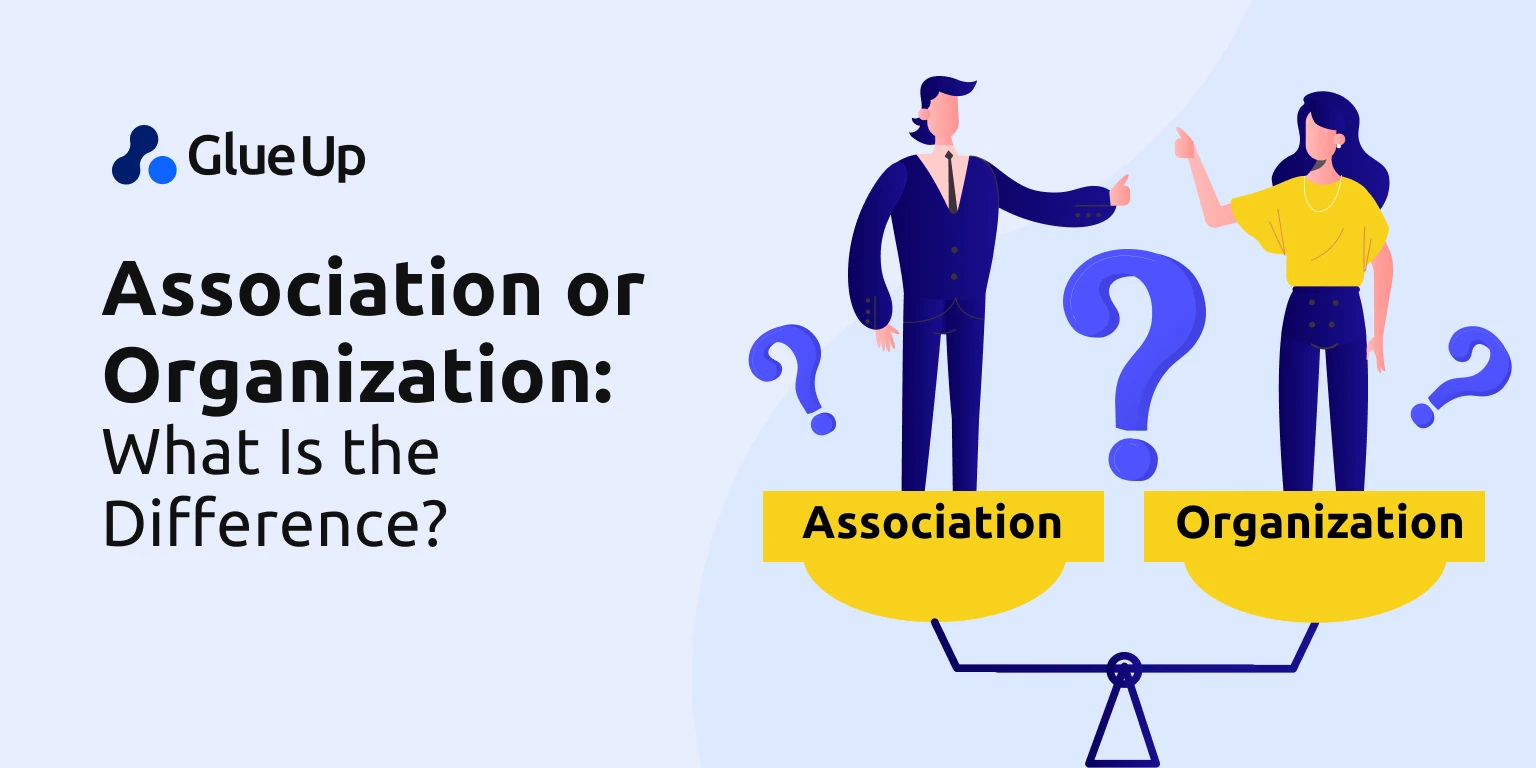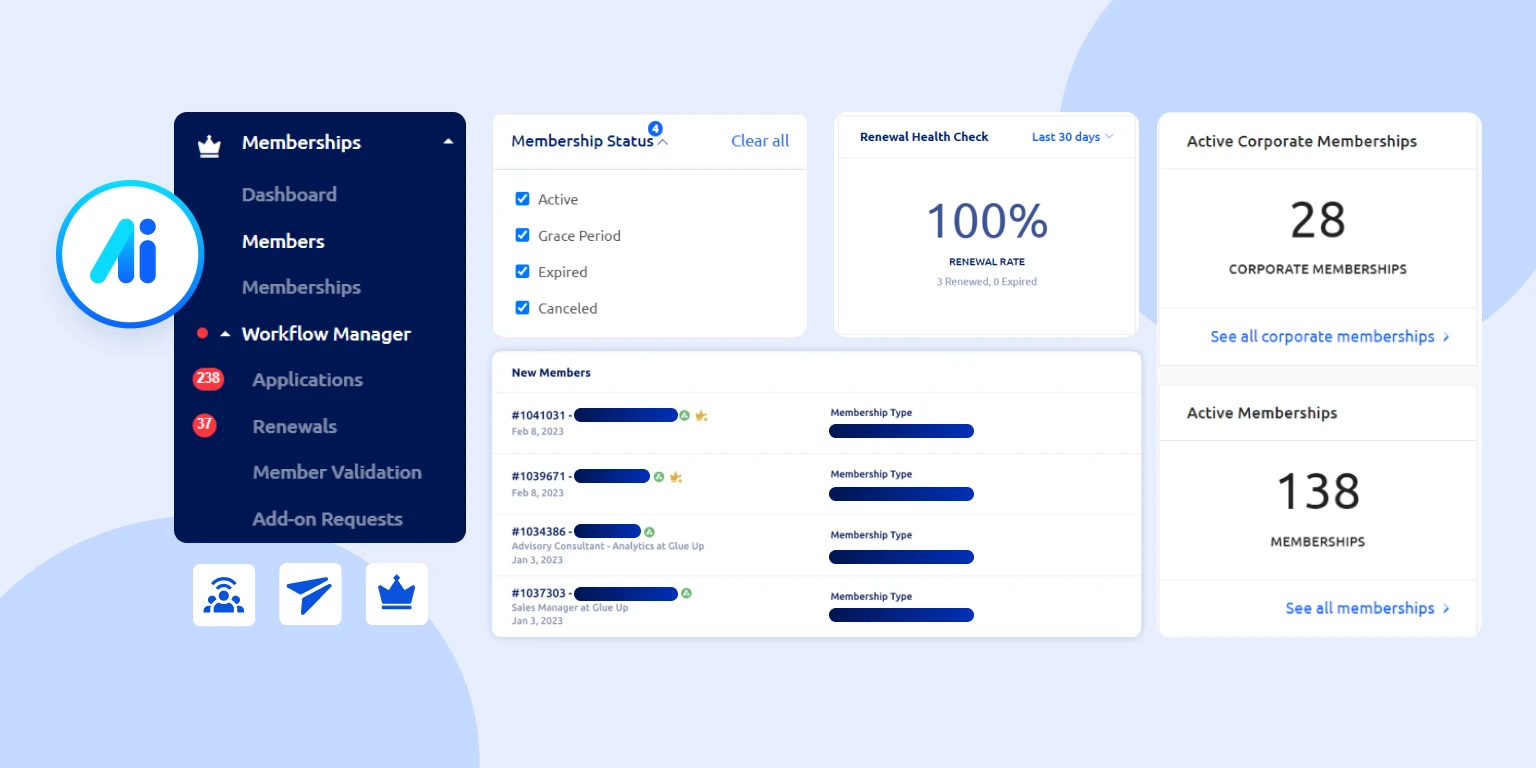
Most people think associations and organizations are the same, with different names, but that's not the case. An association is a special type of organization, and distinct differences separate these two terms.
In this blog, we will illuminate the unique natures of associations and organizations and explore how they differ in terms of structure, purpose, membership, and governance.
Read on to thoroughly understand their characteristics and functions.
Key Takeaways
- Associations are typically groups of individuals united by a common purpose or interest. Organizations, however, are broader entities that can be for-profit or nonprofit, structured to achieve specific goals and manage resources efficiently.
- Associations offer numerous benefits, including resource pooling, knowledge sharing, and effective collaboration. These benefits help members achieve their collective objectives more efficiently.
- Organizations provide a structured approach to achieving specific objectives, whether business-related, social, educational, or charitable, and help build a recognizable brand, foster innovation and growth, and influence markets or communities.
- Examples of associations include the American Medical Association and Rotary International. Examples of organizations include Apple Inc., the Red Cross, and the United Nations. These examples demonstrate the diversity in structure, purpose, and function between associations and organizations.
- Glue Up is an all-in-one AI-powered management software that streamlines operations and improves efficiency for associations and organizations. Its comprehensive suite of tools can transform how entities manage their processes, making it an invaluable solution for enhancing management efficiency.
What Is an Association?

An association is a group of individuals or entities united by a common purpose or interest. Associations can be either nonprofit or for-profit, depending on their structure and goals.
These entities are typically governed by a set of bylaws and a board of directors. Activities within associations may include advocacy, education, networking, and providing member services.
Membership can be either voluntary or mandatory, depending on the association's requirements. Members share a common goal or profession and work together to achieve collective objectives.
Why Create an Association?
Creating an association offers numerous benefits for individuals or entities with a shared interest or purpose. It provides a structured platform for achieving collective objectives and develops a sense of community among its members. Here are some key reasons to create an association:
- Resource Pooling: Members can combine their resources, including time, money, and expertise, to achieve goals more efficiently.
- Knowledge Sharing: Associations facilitate the exchange of information and best practices among members, enhancing their overall knowledge and skills.
- Effective Collaboration: Working together allows members to tackle larger projects and initiatives that might be difficult to manage individually.
- Advocacy and Influence: Associations can represent the collective interests of their members, providing a unified voice to influence policy and decision-making processes.
- Education and Professional Development: Associations often offer training, certifications, and other professional development opportunities to help members grow in their fields.
- Networking Opportunities: Members can connect with peers, industry leaders, and potential partners, expanding their professional networks.
- Standard Setting: Associations help establish and promote industry standards and best practices, ensuring quality and consistency.
- Member Services: Associations can provide valuable services, such as access to specialized resources, discounts, and exclusive events.
Moreover, forming an association helps members amplify their impact, enhance their capabilities, and work more effectively towards their common goals.
Examples of an Association
Though associations can be of many types, here are a few examples listed:
- Professional Associations: Associations that bring together individuals from the same profession to promote professional development, set standards, and advocate for their interests (e.g., American Medical Association, Bar Associations).
- Trade Associations: Groups formed by businesses within the same industry to address common concerns, set industry standards, and advocate for regulatory or policy changes (e.g., National Association of Manufacturers, American Petroleum Institute).
- Charitable Associations: Nonprofit organizations focused on philanthropic activities and social causes, often relying on donations and volunteer efforts (e.g., Red Cross, Habitat for Humanity).
- Cultural and Artistic Associations: Organizations dedicated to promoting and preserving cultural, artistic, and heritage activities (e.g., art societies, historical societies).
- Educational Associations: Groups that support educational institutions, educators, and students, often providing resources, advocacy, and professional development (e.g., National Education Association, American Association of Community Colleges).
- Recreational and Sports Associations: Organizations that facilitate recreational activities, sports, and physical fitness (e.g., local sports leagues, national athletic associations).
- Social and Fraternal Associations: Clubs and societies that provide social interaction, mutual support, and community service opportunities (e.g., Rotary Clubs, Lions Clubs, fraternities, and sororities).
- Health and Wellness Associations: Groups focused on promoting health, wellness, and medical research, often advocating for public health policies and supporting patients and healthcare providers (e.g., American Heart Association, Mental Health America).
- Environmental Associations: Associations dedicated to environmental conservation, sustainability, and advocacy (e.g., Sierra Club, World Wildlife Fund).
- Political and Advocacy Associations: Groups that work to influence public policy, support political candidates, or advocate for specific issues or causes (e.g., AARP, National Rifle Association).
- Religious Associations: Associations that support religious activities and community outreach efforts (e.g., church groups, interfaith councils).
- Labor Unions: Associations representing workers in various industries, negotiating wages, benefits, and working conditions on their behalf (e.g., United Auto Workers, American Federation of Teachers).
What Is an Organization?

An organization is a structured group of individuals or entities that come together to achieve specific goals or purposes. Organizations can be for-profit, aiming to generate revenue and profit, or nonprofit, focusing on social, educational, or charitable missions.
However, they typically have a defined hierarchy of roles and responsibilities and are governed by rules and procedures.
Organizations operate through coordinated efforts and systematic processes to achieve their objectives. They may consist of various departments or divisions, each with specific functions that contribute to the overall mission.
An organization's structure and strategy are designed to effectively utilize resources, manage operations, and adapt to changing environments to ensure long-term success and sustainability.
Why Create an Organization?
Creating an organization offers several key benefits and serves various purposes:
- Achieve Specific Goals: Organizations provide a structured approach to achieving specific objectives, whether they are business-related, social, educational, or charitable.
- Resource Management: Organizations enable efficient management of resources, including human, financial, and physical assets, to maximize productivity and effectiveness.
- Coordination and Collaboration: Establishing an organization facilitates coordinated efforts and collaboration among individuals or groups, ensuring that everyone works towards common goals.
- Legal and Financial Structure: Organizations provide a legal and financial framework that can help secure funding, protect members or employees, and ensure compliance with regulations.
- Brand and Identity: Creating an organization helps in building a recognizable brand and identity, which can enhance credibility, attract clients, members, or donors, and foster loyalty.
- Innovation and Growth: Organizations can create an environment that encourages innovation, development, and growth, allowing for the continuous improvement of products, services, or programs.
- Market or Community Influence: Organizations can significantly influence markets or communities by advocating for policies, driving industry standards, or addressing societal needs.
Overall, creating an organization enables the systematic pursuit of goals, efficient resource utilization, and the ability to make a meaningful impact in a chosen field or community.
Examples of an Organization
Here are a few examples of different types of organizations:
- Corporations: For-profit entities that engage in business activities to generate revenue and profit (e.g., Apple Inc., Google LLC).
- Nonprofit Organizations: Entities focused on social, educational, or charitable missions without the goal of profit (e.g., Red Cross, World Wildlife Fund).
- Government Agencies: Public sector organizations that provide services and enforce regulations (e.g., Department of Education, Environmental Protection Agency).
- Educational Institutions: Schools, colleges, and universities that provide education and conduct research (e.g., Harvard University, Stanford University).
- Healthcare Organizations: Entities that provide medical services and promote public health (e.g., Mayo Clinic, American Cancer Society).
- Small Businesses: Independently owned and operated companies that serve local or niche markets (e.g., local restaurants, boutique shops).
- International Organizations: Entities that operate across multiple countries to address global issues (e.g., United Nations, World Health Organization).
- Financial Institutions: Organizations that provide banking, investment, and financial services (e.g., JPMorgan Chase, Goldman Sachs).
- Technology Companies: Organizations that develop and sell technology products or services (e.g., Microsoft, Amazon).
- Retail Chains: Companies that operate a network of retail stores selling various goods (e.g., Walmart, Target).
Each of these examples represents a different type of organization, demonstrating the diversity in structure, purpose, and function.
What Is the Purpose of Associations and Organizations?
Associations and organizations serve various purposes tailored to the needs and goals of their members or constituents. Associations focus on professional development, improving networking and advocacy, setting industry standards, providing resources, and building a sense of community. They help members connect, learn, and advance their interests collectively.
Organizations are a broader category that aims to achieve specific objectives, whether business-related, social, educational, or charitable. They manage resources efficiently, facilitate collaboration, and ensure legal and financial compliance.
Organizations also build brands, encourage innovation, and influence markets or communities through advocacy and standard-setting. Meanwhile, associations support member interests, and organizations focus on broader goals and effective resource management, both playing vital roles in promoting growth, development, and community engagement.
What Is the Difference Between an Association and an Organization?

Association is a special type of organization with its distinct structure, purpose, focus, and size:
Associations
- Purpose: Associations are typically formed to support and advance the interests of their members, who usually share a common profession, industry, or interest.
- Membership: Membership in associations is often voluntary, with members joining to gain benefits such as professional development, networking, and advocacy.
- Activities: Associations engage in activities like setting industry standards, providing training and certification, conducting research, and lobbying for policy changes.
- Structure: They are usually governed by a set of bylaws and a board of directors, and they focus on member services and community-building.
- Size: Associations can vary in size, from small local groups to large national or international entities, but they are often smaller than large-scale organizations.
Organizations
- Purpose: Organizations are broader in scope and can be formed for various purposes, including business, social, educational, or charitable goals. They aim to achieve specific objectives and manage resources effectively.
- Membership: Membership or participation in organizations can be either voluntary or mandatory, depending on the type and purpose of the organization.
- Activities: Organizations focus on achieving their specific objectives through coordinated efforts and systematic processes. This can include business operations, service delivery, advocacy, and innovation.
- Structure: Organizations have a structured hierarchy with defined roles and responsibilities. They ensure compliance with legal and financial regulations and aim for sustainable growth and impact.
- Size: Organizations tend to be larger and more complex, often encompassing multiple departments or divisions, and can operate on local, national, or global scales.
What Are the Similarities Between Associations and Organizations?

Associations have a lot in common with the broader category of organizations, such as structure, purpose, and focus. Here are some key similarities:
Governance and Structure
- Bylaws and Policies: Both associations and organizations operate under a set of bylaws or policies that guide their operations and governance.
- Leadership: They typically have an effective leadership strategy and structure, such as a board of directors or executive team, responsible for making strategic decisions and ensuring the entity's smooth functioning.
Objectives
- Goal-Oriented: Both are established to achieve specific goals or objectives, whether those are related to professional development, advocacy, business success, or social impact.
- Strategic Planning: Both entities engage in strategic planning to outline their long-term vision, mission, and goals, and to develop plans to achieve these objectives.
Membership and Participation
- Member/Participant Engagement: Both rely on the active engagement of their members or participants to fulfill their missions. This can include attending meetings, participating in events, or contributing to initiatives.
- Community Building: Both aim to build a sense of community among their members or participants, promoting networking, collaboration, and mutual support.
Activities and Services
- Events and Meetings: Both associations and organizations often hold events, conferences, and meetings to bring together their members or stakeholders for networking, learning, and collaboration.
- Education and Training: They provide educational resources, training programs, and professional development opportunities to enhance the skills and knowledge of their members or participants.
Advocacy and Influence
- Advocacy Efforts: Both can engage in advocacy efforts to influence public policy, regulations, or industry standards to benefit their members or the broader community.
- Representation: They represent the interests and concerns of their members or participants in various forums, ensuring their voices are heard in relevant discussions and decisions.
Resource Management
- Financial Management: Both require effective financial management, including budgeting, fundraising, and financial reporting, to sustain their operations.
- Resource Allocation: To achieve their goals, they allocate resources, such as time, money, and human capital, to various projects and initiatives.
Communication
- Information Dissemination: Both use various communication channels, such as newsletters, websites, and social media, to disseminate information, updates, and resources to their members or participants.
- Feedback Mechanisms: They often have mechanisms in place to gather feedback from their members or participants to improve services and address concerns.
Overall, associations and organizations share commonalities in governance, objectives, membership engagement, activities, advocacy efforts, resource management, and communication. Both types of entities aim to achieve specific goals, support their members or participants, and make a positive impact within their respective domains.
Nonprofits: Association or Organization?
Nonprofits can be either associations or organizations, depending on their structure and purpose.
Nonprofit associations, such as professional associations like the American Medical Association, are typically member-driven, focusing on supporting and advancing the interests of their members. They often engage in activities like advocacy, professional development, and networking.
Nonprofit organizations, on the other hand, have broader missions aimed at serving the public good, such as charities and foundations like the Red Cross or Habitat for Humanity. These entities may provide services, conduct research, or support various social causes.
In summary, nonprofits can take the form of either associations or organizations, distinguished by their focus on member interests or broader public missions.
Whether an Association or an Organization, You Need This Management Software

Management software is the ultimate solution for organizations and associations. A solution like Glue Up, with its all-in-one AI-powered management capabilities, can significantly streamline operations and improve efficiency.
Let's explore its features and how they can benefit your entity.
Membership Management
- Customizable Renewal Flows: Simplify the membership renewal process with tailored workflows.
- Automatic Reminders: Ensure members never miss a renewal or important update with automated reminders.
- Membership Directory: Maintain an organized and accessible directory of all members.
- Recurring Payments: Facilitate hassle-free recurring payments for memberships.
Event Management
- Branded Event Invitations: Create and send professional, branded invitations for your events.
- Automated Notifications: Keep attendees informed with automated event notifications.
- Social Media Integration: Promote events through seamless integration with social media platforms.
- List Segmentation: Target specific groups with segmented attendee lists for more effective communication.
Community Management
- Live Feed: Engage your community with a dynamic live feed for updates and discussions.
- Comments & Discussions: Foster interaction through comments and discussion threads.
- Social Sharing: Expand your reach by enabling social sharing of content.
- Participant Directory: Maintain a directory of participants for easy networking.
- Public & Private Groups: Create and manage public and private groups for targeted interactions.
CRM
- Centralize Data: Centralize all your data in one place and gain deep insights into your members and activities.
Email Campaigns
- Personalized Communications: Personalize your email campaigns to grow your organization and keep members engaged.
Finance & Invoicing
- Streamline Transactions: Simplify the entire transaction experience, from invoicing to payment processing.
Community
- Dedicated Space: Provide your community with a dedicated space to connect and engage with your organization.
Glue Up combines these powerful features to enhance your management processes, making it an invaluable tool for both associations and organizations. Get a demo to see how Glue Up can transform your management processes.
FAQs
What is the difference between an association and an organization?
An association is typically a group of people who come together for a common purpose or interest. It often has voluntary membership and focuses on member benefits like networking and professional development. An organization is a broader term that encompasses any structured group working towards specific goals, including businesses, government agencies, and nonprofits. Organizations often have a formal structure with defined roles and responsibilities.
Can associations and organizations be both for-profit and nonprofit?
Yes, both associations and organizations can be either for-profit or nonprofit. Nonprofit associations usually focus on supporting their members through professional development and advocacy, while nonprofit organizations often aim to serve the public good through various activities. For-profit entities, on the other hand, aim to generate revenue and profit.
What are some examples of associations and organizations?
Examples of associations include the American Medical Association (a professional association) and Rotary International (a service association). Examples of organizations include Apple Inc. (a corporation), the Red Cross (a nonprofit organization), and the United Nations (an international organization).
What is the main difference between a group and an organization?
A group is a collection of individuals who come together for a common purpose but may not have a formal structure or defined roles. An organization is a more formal entity with a structured hierarchy, defined roles and responsibilities, and specific goals or objectives.



